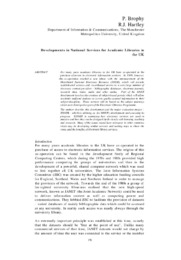| dc.description.abstract | For many years academic libraries in the UK have co-operated in the purchase of access to electronic information services. The origins of this co-operation can be found in the development firstly of Regional Computing Centres, which during the 1970s and 1980s provided high performance computing for groups of universities and then in the development of a powerful, shared computer network which was used to link together all UK universities. The Joint Information Systems Committee (JISC) was created by the higher education funding councils for England, Scotland, Wales and Northern Ireland in order to manage the provision of the network. Towards the end of the 1980s a group of far-sighted university librarians realised that the new high-speed network, known as JANET (the Joint Academic Network) could be used to deliver information content as well as computing power and communications. They lobbied JISC to facilitate the provision of datasets - varied databases of mainly bibliographic data which could be accessed at any university. In reality such access was nearly always through the university library. An extremely important principle was established at this time, namely that the datasets should be “free at the point of use”. Unlike many commercial services of that time, JANET datasets would not charge by the amount of time the user was connected to the service or the number of records they decided to download. Instead the annual costs of the service would be shared between JISC and the individual universities who wished to offer it to their members. The result of this decision was that the volume of use increased massively. At about this time, universities and their libraries had installed clusters of networked PCs on campus. These provided increasingly open access to networked services, including the JISC dataservices. So, instead of online access being the privilege of the few, it became the right of the majority. In order to deliver what were then (and still are) huge datasets, JISC established Bath Information and Data Services (BIDS), as its name implies, at the University of Bath. Over time a further two ‘datacentres’ were established at Manchester (Manchester Information and Data Services (MIDAS), now renamed Manchester Information and Associated Services (MIMAS)) and Edinburgh (Edinburgh Data & INformation Access (EDINA)). Between them, these three datacentres deliver huge amounts of electronic information to academic users throughout the UK - for example, the whole of ISI citation indexes are available through the ‘Web of Science’ service at MIMAS. Various other services offer specialist datasets and support services, including: - AHDS (Arts & Humanities Data Service) · e.g. Archaeology Data Service; History Data Service - RDN (Resource Discovery Network) · Classified Internet resources available via ‘subject gateways’ such as SOSIG (Social Sciences) and EEVL (Engineering) - CHEST · software ‘deals’ for the HE community, enabling institutions to take advantage of consortial purchasing arrangements for software etc. - The Data Archive (at the University of Essex) · large sets of social sciences data - HENSA (HE National Software Archive) · Free software for downloading: PC software at Lancaster University; Unix at the University of Kent at Canterbury. - JISCMAIL · the email service for the UK HE community | en |
